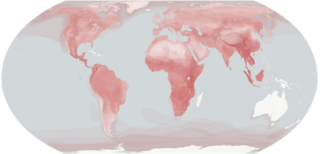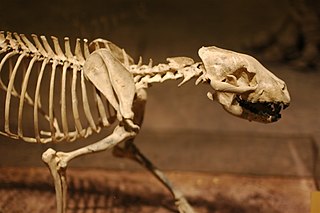
Carnivora is an order of placental mammals that have specialized in primarily eating flesh, whose members are formally referred to as carnivorans. The order Carnivora is the fifth largest order of mammals, comprising at least 279 species on every major landmass and in a variety of habitats, ranging from the cold Polar regions of Earth the hyper-arid region of the Sahara Desert to the open seas. They have a very large array of different body plans with a wide diversity of shapes and sizes.

Canidae is a biological family of dog-like carnivorans, colloquially referred to as dogs, and constitutes a clade. A member of this family is also called a canid. The family includes three subfamilies: the Caninae, the extinct Borophaginae and Hesperocyoninae. The Caninae are known as canines, and include domestic dogs, wolves, coyotes, foxes, jackals and other species.

Amphicyonidae is an extinct family of terrestrial carnivorans belonging to the suborder Caniformia. They first appeared in North America in the middle Eocene, spread to Europe by the late Eocene, and further spread to Asia and Africa by the early Miocene. They had largely disappeared worldwide by the late Miocene, with the latest recorded species at the end of the Miocene in Africa. They were among the first carnivorans to evolve large body size. Amphicyonids are colloquially referred to as "bear-dogs".

Caniformia is a suborder within the order Carnivora consisting of "dog-like" carnivorans. They include dogs, bears, raccoons, and mustelids. The Pinnipedia are also assigned to this group. The center of diversification for the Caniformia is North America and northern Eurasia. Caniformia stands in contrast to the other suborder of Carnivora, the Feliformia, the center of diversification of which was in Africa and southern Asia.

Ailuridae is a family in the mammal order Carnivora. The family consists of the red panda and its extinct relatives.

The extinct Borophaginae form one of three subfamilies found within the canid family. The other two canid subfamilies are the extinct Hesperocyoninae and extant Caninae. Borophaginae, called "bone-crushing dogs", were endemic to North America during the Oligocene to Pliocene and lived roughly 34—2.5 million years ago, existing for about 33.5 million years.
Potamotherium an extinct genus of caniform carnivoran from the Miocene epoch of France and Germany. It has historically been assigned to the family Mustelidae, but more recent studies suggest that it represents a primitive relative of pinnipeds

Barbourofelidae is an extinct family of carnivorans of the suborder Feliformia, sometimes known as false saber-toothed cats, that lived in North America, Eurasia and Africa during the Miocene epoch and existed for about 7.9 million years. Thought to be an independent lineage from the Nimravidae and Machairodontinae, which had all attained elongated canines, recent research argues that it may be a subfamily of the Nimravidae, extending its biochronological range into the Miocene, although this issue is not yet fully resolved.

The Caninae, known as canines, are one of three subfamilies found within the canid family. The other two canid subfamilies are the extinct Borophaginae and Hesperocyoninae. The Caninae includes all living canids and their most recent fossil relatives. Their fossils were first found in North America and dated to the Oligocene era, then spreading to Asia at the end of the Miocene era, some 7 million to 8 million years ago.

The extinct Hesperocyoninae are one of three subfamilies found within the canid family. The other two canid subfamilies are the extinct Borophaginae and extant Caninae.
Parictis is an extinct arctoid belonging to the family Subparictidae.

Ursoidea is a superfamily of arctoid carnivoran mammals that includes the families Subparictidae, Amphicynodontidae, and Ursidae. The last family includes the extant lineages of bears, as well as the extinct Hemicyoninae and Ursavinae.

Kolponomos is an extinct genus of carnivoran mammal that existed in the Late Arikareean North American Land Mammal Age, early Miocene epoch, about 20 million years ago. It was likely a marine mammal. The genus was erected in 1960 by Ruben A. Stirton, a paleontologist at the University of California Museum of Paleontology, Berkeley, for the species K. clallamensis, on the basis of a partial skull and jaw found on the Olympic Peninsula. At the time, Stirton questionably assigned it to Procyonidae, its systematic position remained problematic until the discovery of more fossils including a nearly complete cranium from the original locality of K. clallamensis which helped identify it as part of the group from which pinnipeds evolved.
Nothocyon is an extinct genus of carnivoran in the family Subparictidae which inhabited North America during the late Oligocene. At one time, many species of the dog family Canidae were placed in Nothocyon, but new fossils showed that the type species of Nothocyon, N. geismarianus, is more closely related to bears. The other species have been reassigned to other genera such as Cormocyon.

Canis edwardii, also known as Edward's wolf, is an extinct species of wolf in the genus Canis which was endemic to North America three million years ago from the Late Blancan stage of the Pliocene epoch and was extinct by the end of the Irvingtonian stage of the Pleistocene epoch.

Arctoidea is a clade of mostly carnivorous mammals which include the extinct Hemicyonidae (dog-bears), and the extant Musteloidea, Pinnipedia, and Ursidae (bears), found in all continents from the Eocene, 46 million years ago, to the present. The oldest group of the clade is the bears, as their CMAH gene is still intact. The gene became non-functional in the common ancestor of the Mustelida. Arctoids are caniforms, along with dogs (canids) and extinct bear dogs (Amphicyonidae). The earliest caniforms were superficially similar to martens, which are tree-dwelling mustelids. Together with feliforms, caniforms compose the order Carnivora; sometimes Arctoidea can be considered a separate suborder from Caniformia and a sister taxon to Feliformia.

Amphicynodontidae is a probable clade of extinct arctoids. While some researchers consider this group to be an extinct subfamily of bears, a variety of morphological evidence links amphicynodontines with pinnipeds, as the group were semi-aquatic otter-like mammals. In addition to the support of the pinniped–amphicynodontine clade, other morphological and some molecular analyses support bears being the closest living relatives to pinnipeds. According to McKenna and Bell (1997) Amphicynodontinae are classified as stem-pinnipeds in the superfamily Phocoidea. Fossils of these mammals have been found in Europe, North America and Asia. Amphicynodontines should not be confused with Amphicyonids (bear-dogs), a separate family of Carnivora which is a sister clade to arctoids within the caniforms, but which may be listed as a clade of extinct arctoids in older publications.

Cerdocyonina is an extant subtribe of the canines and is exclusively endemic to the Americas. Often described to be "fox-like" in appearance and behavior, they are more closely related to the wolf-like canids such as Canis than they are to the fox genus Vulpes. Its members are colloquially known as the South American canids and there are 10 extant species. They are sometimes referred to as South American foxes in the older literature, but the term zorro has been recommended by mammalogists to avoid confusion with the true foxes of the tribe Vulpini, which includes the genus Vulpes.
Subparictis is an extinct genus of carnivoran mammals in the family Subparictidae that inhabited North America.














